|
International
and National News |
U.S. Secretary of State Condoleezza
Rice
to attend European parley on Middle East
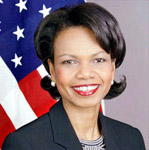 WASHINGTON,
D.C. (Press Release)—Secretary of State Condoleezza Rice will travel to
Berlin, Vienna, and Madrid tomorrow (May 29) to Friday (June 1). WASHINGTON,
D.C. (Press Release)—Secretary of State Condoleezza Rice will travel to
Berlin, Vienna, and Madrid tomorrow (May 29) to Friday (June 1).
On May 30, Secretary Rice will attend the G8 Foreign
Ministerial in Potsdam, Germany. On May 31, she will travel to Vienna for
the
Condoleezza Rice
Women's Empowerment Strategy
Group and the Roundtable on Networking for Peace and Security in the Middle
East. On June 1, the Secretary will visit Madrid for meetings with Spanish
officials.
The foregoing article was provided by the office of Secretary of State
Condoleezza Rice.
Israel
Museum displays Greek stele; 'Silent Era' manuscript; 19th century European
views of 'Eden'
JERUSALEM—The Israel
Museum has one of the world's best known collections from the worlds of art and
archaeology, including the Dead Sea Scrolls lodged in its iconic Shrine of the
Book. Among 19 current exhibitions located in various rooms and nooks of
the sprawling museum are four we'd like to highlight. Two are on long-term
display; two others will be viewable only through mid-June.
Taken together they span some 2200 years. Here, based on press releases
provided by the Israel Museum, are descriptions of a pre-Maccabean era Greek
stele; a manuscript from the so-called 'Silent Era' for Hebrew-language
artifacts; an exhibit on 19th century views of Eden and a retrospective on the
works of Avraham Ofek:
Greek Stele
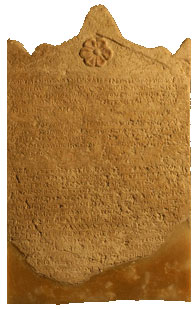 A unique
2,200-year-old stele (inscribed stone block) that provides new insight into the
dramatic story of Heliodorus and the Temple in Jerusalem, as related in the
Second Book of Maccabees, is now on display at the Israel Museum A unique
2,200-year-old stele (inscribed stone block) that provides new insight into the
dramatic story of Heliodorus and the Temple in Jerusalem, as related in the
Second Book of Maccabees, is now on display at the Israel Museum
“The Heliodorus stele is one of the most important and revealing Hellenistic
inscriptions from Israel,” said James S. Snyder, Anne and Jerome Fisher Director
of
the Israel Museum. “It contextualizes the Second Book of Maccabees and provides
an independent and authentic source for an important episode in the history
leading
up to the Maccabean Revolt, whose victorious conclusion is celebrated each year
during the Jewish festival of Hanukkah.”
This presentation marks the first public display of the
Heliodorus stele, which is on extended loan to the Museum from Michael and Judy
Steinhardt of New York. The stele documents a correspondence in ancient Greek
between Heliodorus and King Seleucus IV, ruler of the Seleucid Empire from 187
to
175 BCE, who was succeeded by Antiochus IV Epiphanes (best known from the
story of Hanukkah). In his letter, King Seleucus announces the appointment of an
administrator to oversee the sanctuaries within the province that included the
Land
of Israel.
The appointment of an overseer of the sanctuaries - including the Temple in
Jerusalem - was intended to bring the province into line with the rest of the
Seleucid
Empire. This position included authority over the sanctuaries’ revenues and,
above
all, taxes due to the king. It is likely, however, that the Jews regarded this
appointment as an infringement of Jewish religious autonomy.
'Silent Era' Manuscript
An extremely rare and never-before-exhibited Hebrew scroll fragment from what is
known as the "silent era" – the six-hundred year period from the 3rd through 8th
centuries CE from which almost no Hebrew manuscripts have survived—is now on
long-term display at the Israel Museum.
(jump to
continuation)

|
Your specialist in
cruises and tours
Upcoming 2007 San Diego sailings:
May 27-December 29: Carnival:
Elation: multiple 4-and 5-day sailings, round trip to Mexico.
Sept 23-Dec 30: Princess Cruises: Dawn Princess: 7-day round trip to
Mexico
Sept. 28: Celebrity Cruises: Summit: 14-day Hawaii
Sept. 29: Holland America: Oosterdam, 7-day Mexico. |
 Jews
in the News Jews
in the News
-------------------------------------------------------------------------------
Like you, we're pleased when members of our community are
praiseworthy, and are disappointed when they are blameworthy.
Whether
it's good news or bad news, we'll try to keep track of what's being said in
general media about our fellow Jews.
Our news spotters are Dan Brin in Los Angeles, Donald H. Harrison in San Diego,
and you. Wherever you are, if you see a story of interest, please send a
summary and link to us at sdheritage@cox.net.
To see a source story click on the link within the respective paragraph.
_______________________________________________________________________
*Public relations consultant Jack
Berkman has announced an anonymous donor has contributed $150,000 to permit
the Harborside Charter School to finish its semester. The
story by Tony Manolatos is in today's San Diego Union-Tribune.
*Judy Bernstein, San
Diego-area staff member for the International Rescue Committee, is filled with
admiration for
Daniel Akech Thiong,
a former "Lost Boy of the Sudan" who
earned bachelor's degrees in theology and mathematics from the University of San
Diego. Dean Calbraith has the
story in today's San Diego Union-Tribune.
*Margy Feldman, president and chief executive of Jewish Big Brothers/
Big Sisters reports that 90 percent of the children the group sends to
Camp Max Straus are members of families who live below the poverty line.
The
story by Amy Kaufman is in today's Los Angeles Times.
*Gabe Cohen, an outfielder for UCLA, has been selected by Pac-10
coaches as a co-newcomer of the year along with USC shortstop Grant Green. The
story by Gary Klein is in today's Los Angeles Times
*New York Mayor Michael Bloomberg has sponsored the transformation of
the city government's television channel from a hodgepodge of televised meetings
to a lively presenter of "The Secrets of New York." Its star, Kelly Choi,
is a journalist and former model. Erika Hayasaki has the
story in today's Los Angeles Times.
*Harold
Goldstein, executive director of the California Center for Public Health
Advocacy, was shocked when he heard a description of Burger King's Quad-Stacker
which includes
four meat patties, four slices of cheese and eight slices
of bacon. There ought to be a law to require restaurants to explain the
nutritional content of such offerings, he says. The
story by Michael Stetz is in today's San Diego Union-Tribune.
*TreePeople founder Andy Lipkis said the recent big fire at Griffith
Park did some beneficial work that others were unwilling to do: remove some
invasive species from the area. The
story by Deborah Schoch and Ashraf Khalil is in today's Los Angeles
Times.
*The Blessings of a Broken Heart
by Sherri Mandell has been adapted into a new play by Associate
Director Todd Salovey.
The
story by Anne Marie Welsh appears in today's San Diego Union-Tribune.
*Adam Mendelsohn, a spokesperson for California Gov. Arnold
Schwarzenegger, says a bullet train to link California's cities is not a top
priority. But David Crane, a member of the California High Speed Rail
Authority, isn't giving up. He wants a meeting with House Speaker Nancy
Pelosi and U.S. Senators Barbara Boxer and Dianne Feinstein, all
California Democrats, to work out a financing plan. The
story by George Skelton is in today's Los Angeles Times.
*Israel's Prime Minister Ehud Olmert,
under domestic pressure to do something about the continuing rocket attacks on
Sderot, declared that as Israel retalliates "no one is immune"—which some
observers took as a warning that targeted assassinations of top Hamas leaders
may be in store. The
story, based on Associated Press and New York Times News Service material,
is in today's San Diego Union-Tribune.
*U.S. Senators Arlen Specter of Pennsylvania and Kay Bailey Hutchison
of Texas, Republicans on opposite sides of the immigration debate, have said
they believe they can work out a compromise. The
story by Molly Hennessy-Fiske is in today's Los Angeles Times.
*Marcia Zerivitz, chief curator and founding executive director of
the Jewish Museum of Florida in Miami Beach,
recommends to the new Haitian museum that
it not be overly concerned with establishing the provenance of some items
brought by immigrants. If nothing else, the art works' history can start with
their arrival. The Associated Press
story by Jennifer Kay is in today's Los Angeles Times.
(return to top)
__________________________________________
The Jewish Grapevine
 ----------------------------------------------------------------------------------------------------------------- -----------------------------------------------------------------------------------------------------------------
CYBER-REFERRALS—Bruce Kesler noted an
article on the
European Jewish Press website about Japanese Emperor Akihito and empress Michiko
visiting a site in Vilnius, Lithuania, dedicated to the memory of Chiune
Sugihara, the consul who issued life-saving visas to Jews seeking to escape
Nazism. ... Christian Micoine of Santa Fe, N.M., noted an
article about Italians angry at Barbra Streisand for the high ticket
prices for an upcoming concert.
ISRAEL-SAN DIEGO CONNECTIONS—To celebrate the 40th anniversary of the
reunification of Jerusalem, Congregation Adat Yeshurun has decided to theme its
annual fundraising event on Sunday, June 24, as "A Night in Jerusalem."
According to Hillel Mazansky, "the minute you walk through Lion's Gate at
the entrance you will be transported into the heart of the Old City.
Gourmet Israeli food will be served, a special tasting of selected Israeli wines
will accompany passed hors d'ouevres, and a live band will entertain guests."
Live and silent auctions also are planned at the $180-per-person dinner starting
at 6 p.m. at the Orthodox congregation located at 8625 La Jolla Scenic Drive
North, La Jolla. More information may be obtained from the synagogue at
(858) 535-1196, or by emailing Annette at
info@adatyeshurun.org
|
 |
|
Arts,
Entertainment & Dining |
Israeli
entries well received at Cannes Film Festival
CANNES, France (Press release)—The 60th
Cannes Film Festival featured a plethora of new Israeli productions, two of
which won prestigious prizes.
The first of the
Israeli films screened was director Rephael Nadjari's "Psalms", which tells the
story of the crisis a Jerusalem family goes through after the father's
disappearance. The film was exceptionally well received, and the audience gave
the director and actors a standing ovation.
Eran Kolirin's
'The Band's Visit', competing for the Un Certain Regard prize, which awards
young talent and encourages innovative and audacious works, was awarded the
'Coup de Coeur du Jury' by the Jury of the FIPRESCI (International Federation of
Film Critics). The film was also awarded the 26th Youth Prize in the Un Certain
Regard section. This award enables a jury comprised of young film lovers to give
their verdict about films screened in the Competition and Un Certain Regard
sections.
This is the
first Israeli-French co-production of a feature film. The film, which deals with
the journey of an Egyptian police band that gets lost while on a tour of Israel,
received many praises and was bought for distribution in many countries,
including the United States
A third
cinematographic triumph was claimed by writers Shira Geffen and Etgar Karet,
whose first film "Meduzot" (Jellyfish), won the Camera d'Or award for the best
film by debut directors. It also won the French Artist and Writers Guild's (SACD)
best director award and the TV5Monde's "Young Critics" award, awarded by a jury
of 36 French students.
The film evolves
around the lives of three women living in Tel Aviv. Verging on the absurd, the
film portrays a messy world where everyone must get by as best she can – looking
for love, looking for something to remember . . . and sometimes to forget.
Meduzot is not
the first Israeli movie to receive the Camera d'Or. That honor went three years
ago to director Keren Yedaya's "Or" ("My Treasure"), about a teenage girl who
does all she can to support her prostitute mother.
Meduzot's
success is one more notch in the belt of Israeli cinema, which has done well at
international film festivals in recent years. Previously this year, Dror
Shaul's "Adama Meshugaat" won the World Cinema Jury Prize for dramatic films at
the Sundance Festival, and Joseph Cedar's "Beaufort" won the Silver Bear Best
Director Award at the Berlin Film Festival.
The foregoing article was provided by Israel's Foreign Affairs
Ministry
_______________________________________________________
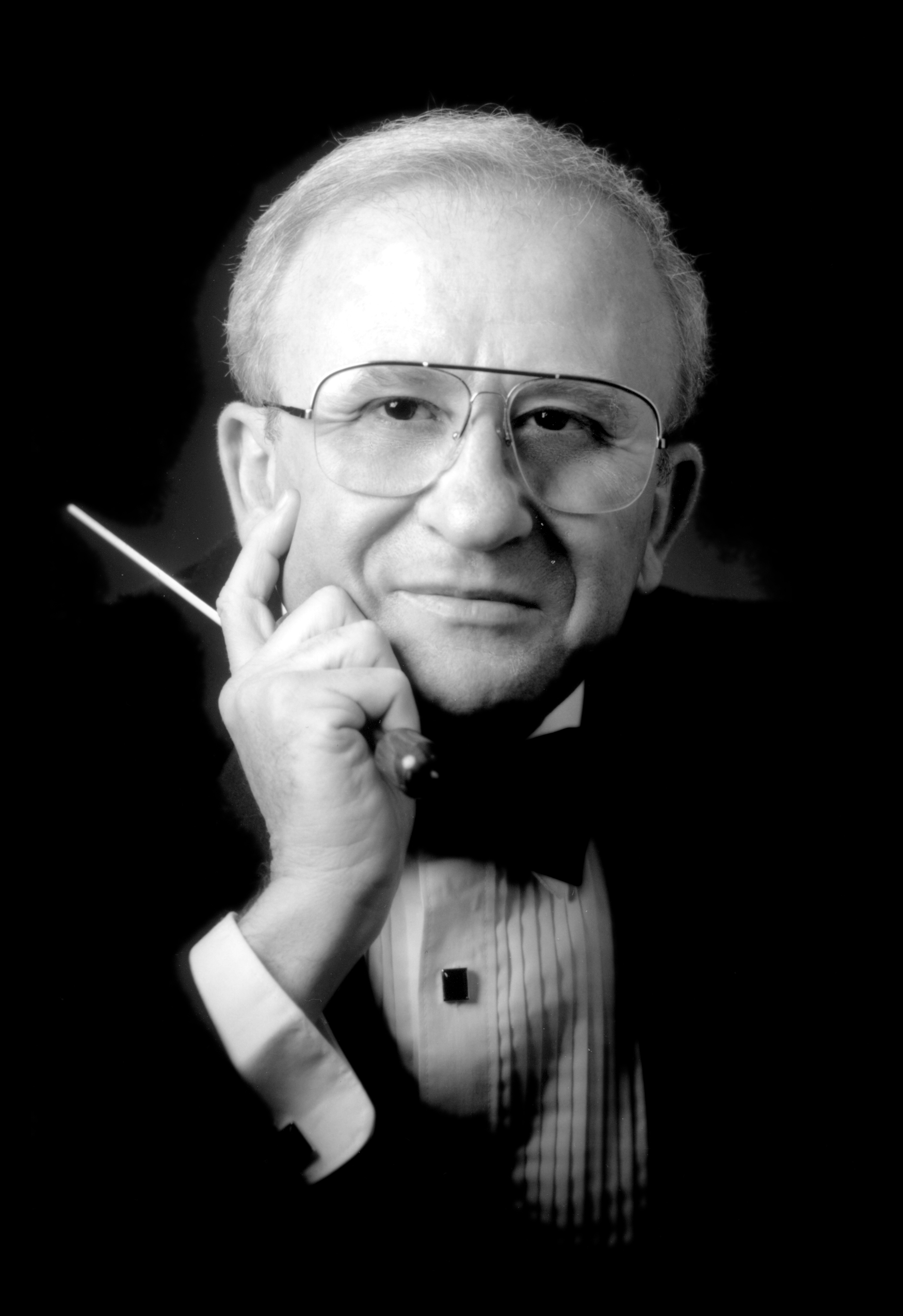 Musical
Notes Musical
Notes
 by David Amos_
_____________________________________________________
by David Amos_
_____________________________________________________
Just what do we
expect from music?
Do we want it to be all-candy for the ears, or do
we want it to provoke us? To challenge us? Would we accept to go to a theatre
play, or to watch a film, or to read
a novel where everybody is sweet, and everybody is nice, and everything smoothly
goes from one step to the next? Smiles in everyone’s faces?
My guess is that you would be bored to tears! You
would expect a novel, play, film to have a certain amount of bite and provoking
challenges, whether it is a serious drama or a comedy.
It’s the same with music. We may wish to have a
comfort level with music, be it familiarity, a story, or another point of
reference. But if the music only provides a fuzzy comfort and nothing else, 1)
It loses its value as an art form, 2) It does not challenge our minds, and
therefore, it becomes easily forgettable. It is like trying to eat dessert only
for every meal, every day. Maybe it would be fun for a while, but you can guess
the consequences. A diet like that is not healthy for the organism.
I love the tunes of The Sound of Music; Fiddler on the Roof
; and so many other shows, but, at least for me, it can not be a steady diet for
too long. You very well know what a diet of pure sugar will do to you.
In the same way, music that is entirely bland is
not harmful, but is definitely not healthy for the mind or the spirit. It serves
at best as a mild anesthetic, which might be exactly what the doctor ordered if
you like to sleep at concerts.
This is why listening to New-Age music is such a
bore. It is a mind-numbing repetition of the same harmonic and melodic ideas.
Little variation and no challenge whatsoever to our intellect. And yes, music
needs to challenge our intellect; maybe not with full intensity all of the time,
but it certainly has to have that element. Don’t even ask me about Rap!
(Have you heard the clever quip which asks what
do you get when you play New-Age music backwards? The answer is New-Age music!)
During Baroque and into Classical times, the
1600’s and 1700’s, so much of the music was composed for royalty, was meant to
entertain or for ceremonies, and most of the times to be used for background. It
served “functional” purposes. Later, with the mature periods of Mozart and
Haydn, and even more so with Beethoven, music was composed to be heard and given
close and full attention. This happened earlier with operas, music dramas, and
church music. The new way was that while the music was being played, it required
our complete concentration, because it became music with something to say.
Music evolved from being a tool of religious
ceremony, a necessary component for dance, incidental music for drama, and light
entertainment for the privileged, to an art form that to be fully appreciated,
and it demanded no other distractions.
Think about this: How horrible it is to have an
opera, a Mahler symphony, or anything by, say, Stravinsky, blaring away while
you are in the midst of a meaningful conversation with someone. But, how
satisfying can the same music be if you are devoting all your senses, your
undivided attention, and can follow the dramatic line, the story, and what the
composer and/or librettist intended to convey?
Nineteenth Century music
started to be nationalistic, political, intensely personal, and reflected the
feelings of the composer. Look, for example, at great 20th Century
Russian music. It tackles the subjects of war, politics, peace, love, treason,
revolution, social changes, and mental challenges, not simply pretty stuff that
harmlessly and brainlessly floats in and floats out of our consciousness.
This is also reflected in the visual arts. Look
at the works of the great masters, Picasso, Chagall, and so many more. It is not
just pretty people, animals, vases, or hills.
But, for the same puzzling reason, the general
public is more ready to accept innovations and the “pushing of the envelope” in
drama, literature, theatre, film, dance, and the visual arts than it will allow
in music. Overall, music is quite a bit behind in being accepted in its more
inventive and progressive movements.
You should know, however, that a few serious,
distinguished musicologists have stated that the greatest contribution to the
history of music in the 20th Century is –surprise!--,The American
Popular song!
Nevertheless, if a composer has something to say
and tries to shake you up a little bit to draw your attention, we may find that
offensive. Listen to the insistent, painful, dissonant repeated chords in the
first movement of Beethoven’s Eroica Symphony (No. 3). Cries of
anguish. Definitely a strong political and social statement, not just cuteness.
Shostakovitch’s Fifth Symphony was a protest against unjust criticism.
His Seventh Symphony was about the siege of Leningrad. Prokoffiev’s
Seventh Symphony was also a seemingly mild response to harsh threats from
Soviet authorities, but the joke was on them; it turned out to be valuable work
that cleverly eluded the disapproval of the music censor.
Tchaikovsky’s music, as beautiful as it is, is a
reflection of a troubled soul, |
irradiating painful emotions of mind and body.
___________________

Arts
in Review
by
Carol Davis
___________________________________
I Left My Heart, a tribute to Tony
Bennett,
is a nostalgic success at Welk Resort Theatre
Tony
Bennett may have left his heart in San Francisco, but I left mine in
Escondido after sitting through the musical tribute to him, I Left My Heart,
now in a most enjoyable production at the Welk Resort Theatre in Escondido.
I
know it may sound corny, but yours truly is a sucker for
all that sentimental balderdash, especially when my memory
bank takes me back to those innocent days of my youth. With songs like
“Boulevard of Broken Dreams," “Because of You," “Stranger in Paradise," and “The
Best Is Yet To Come (and that’s just the first set), how can an old ditty like
me not get sentimental over these tunes?
When Frank Sinatra called Tony Bennett “the greatest singer in the world,” I
don’t know that I could totally agree with him, but he surely left his mark over
the years. Sinatra is also credited with suggesting the name change from Anthony
Benedetto to Tony Bennett.

LEFT THEIR HEARTS—Damon
Kirsche, left; Kevin McMahon and Eric Kuntz salute Tony Bennett
I Left My
Heart,
conceived by David Grapes and Todd Olsen
with book by Todd Olsen, is being performed by three of the best-looking,
best-sounding young talent around. Directed by Nick DeGruccio, it stars Damon
Kirsche, Eric Kunze and Kevin McMahon. They don’t try to sound, look or act like
Bennett. They just sing Bennett and they do it professionally and seem to be
having fun at the same time.
All three
tenors have amazing credits to their bios and between them they have performed
in at least 50 musical revues, Broadway musical revivals and/or touring shows
both here and in other cities. McMahon just appeared in The Full Monty
which was here two months ago; Kirsche was recently seen at the Welk in the
tribute to Frank Sinatra in My Way, and Kunze starred in the National
Touring show of Jesus Christ Superstar. No slackers here.
The
setup is quite simple. Nick Fouch’s set is a platform for the great band with
steps on either side of the stage for the performers to move around; somewhat
like a nightclub or cabaret. On one side, at the bottom of the stairs, is a
‘bar’ and on the other side a cocktail table with two leather chairs for the
performers to sit during some of the numbers. Curtains
are
draped in the background and Jennifer Edwards-Northover’s lighting is both
subtle and on target. The performers take turns singing either solo, duet or
harmonizing, sounding somewhat like
“The Forever Plaids” of which McMahon was a member.
The
original piano/vocal arrangements are by Vince di Mura. The band performing at
Welk is made up of Ted Hughart
on
bass, Mike Masessa on drums, Jack Houghton on trumpet while Justin Gray on piano
is the music director. Each of these musicians had an opportunity to give us a
little of their specialtyand they are terrific.
There are
no less than 33 arrangements of his greatest hits, with a few anecdotes thrown
in (like the one about his voice) all performed in 85 min. with no intermission.
The featured music is by some of the best composers we know: Gershwin;
Ellington; Arlen; Porter; Mercer, and Berlin.
The
numbers are arranged in the different stages of Bennett’s 40-year career.
‘The early years’, ‘A tribute to friends parts I, II and III’. ‘The Film Set’,
‘Crazy Rhythm Set’, ‘The Quiet Set’ and ‘The Last Blast’. Believe me, you don’t
have to recognize any of these particular time frames to know that the
80-year-old Bennett is still going strong and managed to survive The Beatles,
The Punker’s and
anything else that came his way. This “Rags to Riches” guy did it ‘His Way’. He
might have “Left His Heart in San Francisco” but he is still “A Lucky So and
So”.
As a
sidebar it was interesting to note that (Benedetto) Bennett,was drafted into the
U.S. Army in 1944 during WWII and there he served as a replacement infantryman
in the 63rd Infantry Division in France and Germany where he narrowly escaped
death several times. At the end of the war he was involved in the liberation of
a Nazi concentration camp near Landsberg. He was also outspoken about the Army’s
racial segregation policies which led him to a demotion in rank and a
reassignment. In 1949 Pearl Bailey asked him to open for her in Greenwich
Village. In 1950 he
cut
a demo and was assigned to Columbia Records by Mitch Miller.
For an
afternoon or evening of just pure nostalgia and entertainment, I Left My
Heart should fill the bill nicely. It plays through July 8.
For more info call the box office at: (760)749-3448 or log on to
www.welkresort.com
See you at the theatre.
Israel Museum...
(continued from above)
The fragment, dating from the 7th or 8th century, is believed to have been part
of
the Cairo Genizah, a vast depository of medieval Jewish manuscripts discovered
in
Cairo's Ben Ezra Synagogue in the late 19th century.
The manuscript is a fragment of a Torah scroll from the book of Exodus
(13:19-16:1), which includes the Song of the Sea, widely recognized as one of
the
most beautiful examples of biblical poetry. The Song celebrates the Israelites'
safe
crossing of the Red Sea, praises the Almighty for vanquishing their enemies, and
anticipates their arrival in the Promised Land.
There are several conjectures as to why very few manuscripts in Hebrew survive
from the period of the 3rd – 8th centuries CE, the most prevalent of these being
the
continuing persecution of the Jews and the related destruction of Jewish
manuscripts.
Biblical manuscripts do exist from this period in Greek, Latin and other
languages,
but it is only from the 9th century onward that Hebrew manuscripts have been
found in greater abundance.
"The Song of the Sea manuscript is one-of-a-kind in terms of its historical and
literary significance," said James S. Snyder, Anne and Jerome Fisher Director of
the Israel Museum.
"It bridges the gap in the period of history between the Dead Sea Scrolls
[1st-2nd
century CE] and the Aleppo Codex [10th century], both of which are permanently
housed in the Shrine of the Book. The opportunity to display this manuscript
fragment alongside the Museum's own remarkable holdings of ancient biblical
texts
provides a unique example of textual continuity that can only be seen here, in
our
Museum's Shrine of the Book, in Jerusalem."
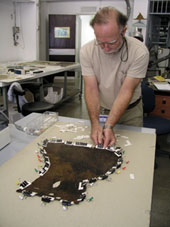 Until
the late 1970s, the Song of the Sea manuscript was part of Until
the late 1970s, the Song of the Sea manuscript was part of
the Hebrew manuscript collection of Lebanese-born American
physician Fuad Ashkar. Dr. Ashkar was not aware of the historical significance
of the Song manuscript until he
contacted Professor James Charlesworth at Duke University, now
the George L. Collord Professor of New Testament Language and
Literature at Princeton Theological Seminary. Carbon analysis
proved that the manuscript dated from "the silent era" of Hebrew
biblical manuscripts and was therefore one of a few of
its kind ever to have surfaced worldwide. The fragment was
Michael Maggen
subsequently housed in the Rare Books, Manuscripts, and Special Collections
Library at Duke University. In 2004, Prof. Charlesworth brought the manuscript
to the attention of Dr. Adolfo Roitman,
and it is now on extended loan to the
Museum. Since its arrival in Jerusalem, the manuscript has undergone extensive
conservation treatment, undertaken by Michael Maggen, head of the Israel
Museum's
Paper Conservation Laboratory, in consultation with Duke University.
19th Century Views of 'Eden'
“Eden – East And West: Art In The 19th Century” is the title of an exhibition
that continues at the Israel Museum through June 18.
The subject of one part of the exhibition is the Middle East and the Land of
Israel
in the 19th Century as a focus of yearning, longing, and curiosity, as well as
of a
patronizing look at the “different” and the “exotic.”
The exhibition shows the artistic expression of these feelings in paintings,
drawings,
photographs, arts and crafts and ethnographic costumes. European painters and
photographers visited biblical sites imbued with religious meaning, producing
portrayals of the local landscape and population.
These views of the East were suffused with holiness, but also with yearning for
the
exotic and the fantastic, the colorful and exciting. Eroticism can also be
found, and
as historians have said: “the motives of the Orient were like screens on which
Europeans projected their fantasies like on a movie screen.”
The exhibition examines the encounter between ideas, feelings, and forms
stemming
from various worldviews and faiths, and it juxtaposes works and objects from
usually separate areas — European art next to Israeli and Islamic art,
paintings,
photos, prints, and drawings, Judaica and ethnography — mostly from the Museum’s
collections. The depictions of holy places on Jewish ritual objects or European
bibelots are shown along with Abel Pann’s paintings of
seductive women; depictions of Jerusalem by artists Turner and Roberts next to
early photographs of these same sites; works of Bezalel artists together with
Maurizio
Gottlieb’s painting of “Jesus in the Temple”; and many other such encounters.
Avraham Ofek
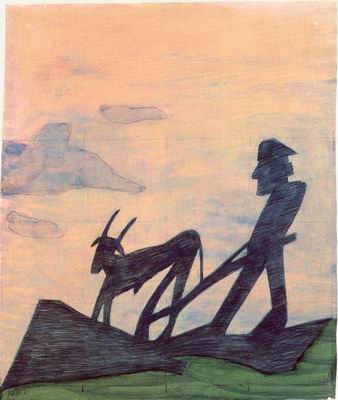 Also
running through June 18 is a retrospective Also
running through June 18 is a retrospective
exhibition of the works of Avraham Ofek.
His early paintings contained portrayals of landscape that were at once lyrical
and
rugged; later in his career, most depictions of
the landscape appeared as undefined
and receded into the background.
Near the end of his life, however, the actual landscape of Jerusalem returned to
assume an important role in Ofek's work, this time embodied in images that
reflect
the loss and despair that engulfed the artist.
Many of Ofek's landscapes are laden with a sense of alienation and solitude, as
well as nostalgia for the city of his birth, Sofia.
The exhibition features some seventy paintings and drawings, and focuses on the
artist's early landscapes of the 1950s and their relationship to those painted
closer to the time of his death in 1990.
The foregoing articles were culled from press
releases issued by the Israel Museum, Jerusalem |


 WASHINGTON,
D.C. (Press Release)—Secretary of State Condoleezza Rice will travel to
Berlin, Vienna, and Madrid tomorrow (May 29) to Friday (June 1).
WASHINGTON,
D.C. (Press Release)—Secretary of State Condoleezza Rice will travel to
Berlin, Vienna, and Madrid tomorrow (May 29) to Friday (June 1).  A unique
2,200-year-old stele (inscribed stone block) that provides new insight into the
dramatic story of Heliodorus and the Temple in Jerusalem, as related in the
Second Book of Maccabees, is now on display at the Israel Museum
A unique
2,200-year-old stele (inscribed stone block) that provides new insight into the
dramatic story of Heliodorus and the Temple in Jerusalem, as related in the
Second Book of Maccabees, is now on display at the Israel Museum
 Jews
in the News
Jews
in the News -----------------------------------------------------------------------------------------------------------------
-----------------------------------------------------------------------------------------------------------------
 Musical
Notes
Musical
Notes 

 Until
the late 1970s, the Song of the Sea manuscript was part of
Until
the late 1970s, the Song of the Sea manuscript was part of  Also
running through June 18 is a retrospective
Also
running through June 18 is a retrospective